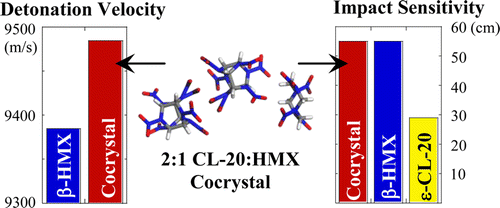Powerful new explosive could replace today's state-of-the-art military explosive

Borrowing a technology used to improve the effectiveness of drugs, scientists are reporting discovery of a new explosive more powerful than the current state-of-the-art explosive used by the military, and just as safe for personnel to handle. Their report appears in ACS' journal Crystal Growth & Design.
Adam J. Matzger and colleagues explain that a technique for engineering medicines and other materials, termed cocrystallization, is attracting attention as a way to make improved explosives, rocket propellants and fireworks. Most solid materials consist of crystals—with atoms and molecules arranged in a specific pattern that repeats itself time and again. Cocrystallization involves combining two materials into a new crystal architecture with the goal of producing an improved material.
They describe cocrystallization of the military's standard explosive, HMX, with a powerful explosive called CL-20, which the authors say is too prone to accidental detonation for military use. Mixing two parts CL-20 with one part HMX, however, produced a new explosive with a blast wave that would travel almost 225 miles per hour faster than that of the purest form of HMX, meaning a much more powerful blast. The new explosive, however, was as stable and resistant to accidental detonation as HMX. They suggest that it has the potential to replace HMX as the new state-of-the art military explosive.
More information: "High Power Explosive with Good Sensitivity: A 2:1 Cocrystal of CL-20:HMX" Cryst. Growth Des., 2012, 12 (9), pp 4311–4314. DOI: 10.1021/cg3010882
Abstract
A novel energetic cocrystal predicted to exhibit greater power and similar sensitivity to that of the current military standard explosive 1,3,5,7-tetranitro-1,3,5,7-tetrazacyclooctane (HMX) is presented. The cocrystal consists of a 2:1 molar ratio of 2,4,6,8,10,12-hexanitro-2,4,6,8,10,12-hexaazaisowurtzitane (CL-20), a powerful explosive too sensitive for military use, and HMX. A predicted detonation velocity 100 m/s higher than that of β-HMX, the most powerful pure form of HMX, was calculated for the cocrystal using Cheetah 6.0. In small-scale impact drop tests the cocrystal exhibits sensitivity indistinguishable from that of β-HMX. This surprisingly low sensitivity is hypothesized to be due to an increased degree of hydrogen bonding observed in the cocrystal structure relative to the crystals of pure HMX and CL-20. Such bonding is prevalent in this and other energetic cocrystals and may be an important consideration in the design of future materials. By being more powerful and safe to handle, the cocrystal presented is an attractive candidate to supplant the current military state-of-the-art explosive, HMX.
Provided by American Chemical Society



















